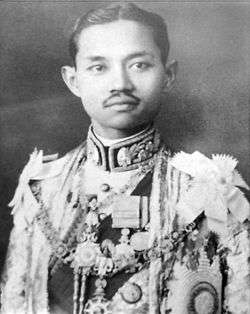Supreme Council of State of Siam

The Supreme Council of State of Siam (Thai: อภิรัฐมนตรีสภา) was an advisory and legislative council established by His Majesty King Prajadhipok of Siam (Rama VII) that existed from 1925 to 1932. The Eton and Sandhurst educated monarch wished to create a council similar to a cabinet, where the most important government officials could meet to decide on state affairs. The Council was founded on 28 November 1925.
Members
The Council was composed of 5 members, each a prince of the Chakri Dynasty who had held ministerial positions during the reigns of King Rama V and Rama VI (Prajadhipok’s father and older brother). The Councillors were:
| Name |
|---|
| Prince Bhanurangsi Savangwongse, The Prince Banubandhu Vongsevoradej |
| Prince Paripatra Sukhumbhand, Prince of Nakorn Sawan |
| Prince Narisara Nuvadtivongs |
| Prince Damrong Rajanubhab |
| Prince Kitiyakara Voralaksana Prince of Chanthaburi |
-

Bhanurangsi Savangwongse
-

Paribatra Sukhumbhand
-

Narisara Nuvadtivongs
-

Damrong Rajanubhab
-

Kitiyakara Voralaksana
The Council was not the only organ of government at the time. The King also had a Privy Council (Thai: สภากรรมการองคมนตรี) and a Council of Secretaries (Thai: เสนาบดีสภา). However, the Supreme Council was regarded as the most important. Prince Paripatra was the most dominant member of the Council of State, since he was then heir to the throne and Minister of the Interior.
History
During its existence the council took many initiatives. For example, in 1929 the Council decided to cut public spending on the government including civil servant’s pay and defence spending, an action which was one of the main justifications the Khana Ratsadon (the People's Party) gave for the Revolution of 1932.
The Council filled many civil service and military positions with their own relatives, replacing many commoners appointed under King Vajiravudh (Rama VI), which also created discontent in the country. The Council increased taxes on the populace to try to stem the economic downturn the country faced after the British Empire, Siam’s largest trading partner, abandoned the gold standard.
The most important action by the Council was the rejection of King Prajadhipok’s draft Constitution for the Kingdom of Siam in early 1932, on the 150th anniversary of the House of Chakri and the foundation of Bangkok. The constitution would have given the people their first parliament, with a popularly elected lower house and an expanded Supreme Council as an upper house. A few months later the Khana Ratsadon staged a coup which ended the absolutist monarchy and replaced it with a constitutional monarchy. The constitution in which they promulgated abrogated the many powers of the monarch and dissolved the Supreme Council; it exiled the influential Prince Paripatra Sukhumband for life.
See also
- Prajadhipok
- Bhanurangsi Savangwongse
- Paripatra Sukhumbhand
- Narisara Nuvadtivongs
- Damrong Rajanubhab
- Kitiyakara Voralaksana
- Siamese Revolution of 1932
- Privy Council of Thailand
References
- Senate of Thailand
- Stowe, Judith A. Siam Becomes Thailand: A Story of Intrigue. C. Hurst & Co. Publishers, 1991